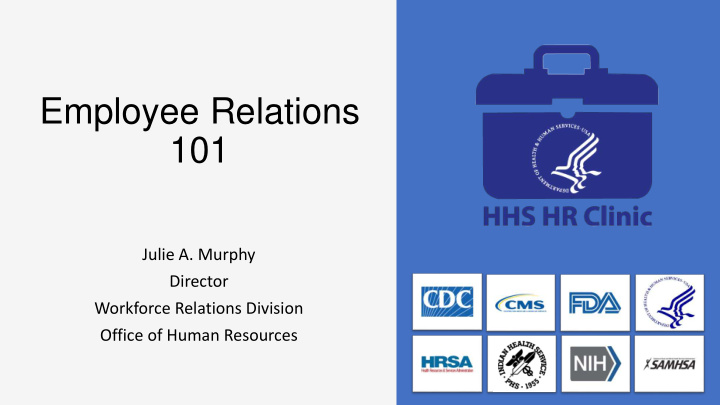



Employee Relations 101 Julie A. Murphy Director Workforce Relations Division Office of Human Resources
Learning Outcomes: You will: Understand the difference between Employee and Labor Relations Have a basic understanding of the role of the Labor and Employee Relations Specialist Have a general understanding of the Employee Relations Process 4/2/2018 Employee Relations 101 2
What is Employee Relations vs. Labor Relations? 4/2/2018 Employee Relations 101 3
ER vs. LR? Employee Relations Labor Relations Directly relates to a Deals with the labor specific employee workforce as a single entity & identifies the parameters for the labor/management relationship 4/2/2018 Title
ER/ R/LR E R Examples es Employee Relations Labor Relations • Conduct Based Actions • Management Rights Examples: Examples: • Insolence/Rude/Disrespectful • Assign work and set the standard for Failure to follow instructions • measurement • Credit Card or computer misuse • Request documentation • Off-duty misconduct • Deny requests in accordance with policy, regulation, and law • Performance Based Actions • Union Rights • Telework/Leave/Attendance issues • Employee Rights • Medical-Related Concerns • Grievances/Arbitration • Reasonable Accommodation
Role of Employee/Labor Relations Specialist 6
ER/LR Specialists are: Management’s Representative Help supervisors/managers do their job and fire employees Agency’s Representative Our job is to protect the agency, not the supervisor 4/2/2018 Title 7
Primary Functions… Listen to the management official! Ask questions - gather facts/evidence Don’t take anything at face value Advise on options within legal boundaries Adjust… 4/2/2018 Title 8
Role of Employee and Labor Relations Specialist EMPLOYEE RELATIONS: • Provide advice and assistance to supervisors for addressing employee concerns, including an explanation of the process from beginning to end (through appeal options) • Discuss options for appropriate management response • Explain interactions of other processes, such as reasonable accommodation, VLTP/ FMLA • Regularly interact with supervisor by phone, follow up in email, etc. • Draft/ Review conduct letters prior to issuance • Attend meetings as needed • Follow-up after issuance to support supervisor • Coordinate with OGC, as appropriate
Role of Employee and Labor Relations Specialist LABOR RELATIONS: • Provide advice, guidance and assistance to supervisors in identifying matters that involve labor relations issues and what to do about them • For example, when a meeting is a “formal meeting” and what that means • Discuss various options • Attend meetings with management • Draft/ Review notices, grievance letters prior to issuance • Explain the role of the union • Agency representative… .
Employee Relations Overview 11
Employee Relations Two separate processes to address unacceptable conduct and/or performance: Conduct – Based (5 C.F.R. 752) Performance – Based (5 C.F.R.432) 12
Conduct – Based Actions • Progressive Discipline : Use lowest level of corrective action to address the misconduct General guide: • Counseling (written or verbal) /Letter of Reprimand • Low-grade suspension – typically below 7 calendar days • High – grade suspension – typically 7 – 14 calendar days • Demotion / Removal • Table of Penalties = A guide, not an obligation 13
Douglas F Fact ctors • The nature and seriousness of the offense, and its relation to • Consistency of the penalty with those imposed upon other the employee's duties, position, and responsibilities, including employees for the same or similar offenses. whether the offense was intentional or technical or inadvertent, or was committed maliciously or for gain, or was frequently repeated. • Consistency of the penalty with any applicable Agency table of penalties. • The employee's job level and type of employment, including supervisory or fiduciary role, contacts with the public, and prominence of the position. • The clarity with which the employee was on notice of any rules that were violated in committing the offense, or had been warned about the conduct in question. • The employee's past disciplinary record. • Potential for the employee's rehabilitation. • The employee's past work record, including length of service, performance on the job, ability to get along with fellow workers, and dependability. • Mitigating circumstances surrounding the offense such as unusual job tension, personality problems, mental impairment, The effect of the offense upon the employee's ability to • harassment, or bad faith, malice or provocation on the part of perform at a satisfactory level and its effect upon supervisors' others involved in the matter. confidence in the employee's ability to perform assigned duties. • The notoriety of the offense or its impact upon the reputation • The adequacy and effectiveness of alternative sanctions to deter of the Agency. such conduct in the future by the employee or others. 4/2/2018 Title 14
Unacceptable Performance – 5 CFR 432 • Based on PMAP and limited to that rating cycle • Opportunity to Demonstrate Acceptable Performance (ODAP) • Typical Process: • PMAP in place for 90 calendar days • Progress review or other communication of unsatisfactory performance • Performance Deficiency Notice – initiating ODAP • ODAP (generally, 30 calendar days) period • Determination: • Successful – must maintain for 1 year from beginning of ODAP • Unsuccessful – demotion or removal 15
Employee Relations Process Right to review Reply (oral and Proposal Letter materials relied Decision Letter / or written) upon 16
Resources • For additional information please visit: • 5 U.S.C. Part 75 and 5 C.F.R. Chapter 752 • 5 U.S.C. Part 43 and 5 C.F.R. Chapter 432 • www.opm.gov • Applicable collective bargaining agreements and HHS Instructions 4/2/2018 Title 17
Questions ? ? ? ? ? ? ? ? ? ? ? ? ? ? ? ? 4/2/2018 Employee Relations 101 18
Julie A. Murphy Contact Information Director Workforce Relations Division Office of Human Resources Assistant Secretary for Administration (202) 260-6555 Julie.Murphy@HHS.gov 4/2/2018 Title 19
Recommend
More recommend